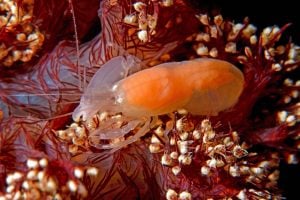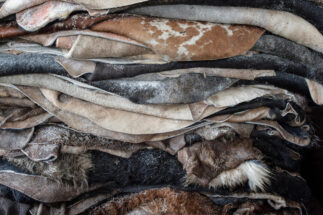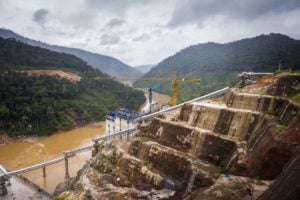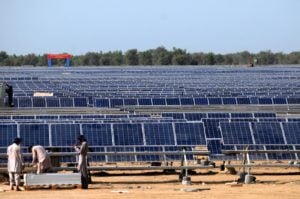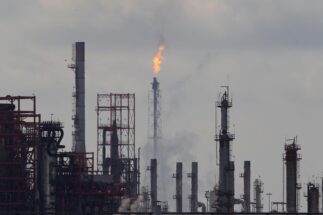Excerpts:
Stella Chen: Let’s turn our lens back to our home base in Hong Kong and mainland China to talk about the impact of noise pollution on marine life here.
Marcy Trent Long: Specifically, how dolphin species are struggling to survive with the increasing development surrounding their habitat along China’s southern coast.
Stella: The Chinese white dolphin is actually pink. This unique species was first recorded as living in the Pearl River Delta region around the 17th century.
Marcy: But this dolphin species is endangered, with only 37 of them left in the waters surrounding Hong Kong.
…
Sarah Yip: I am Sarah Yip. I’m just a very ordinary Hong Kong person. We didn’t actually plan to start marine conservation. We actually quit our jobs in 2015 and travelled around the world. And then when me and my fiancé Rex came back to Cheung Chau island where he was born and raised, we decided to buy a boat. That is how we started our sea life on Cheung Chau island.
…
Sarah: In 2018, there was a beach clean-up on Cheung Chau island that I joined, and I met a WWF lady called June. She invited me to apply for a small funding project called Blue Ocean Interpreter. For a not very big amount, but very encouraging funding from WWF Hong Kong. And so that is how we started our marine conservation jobs.
Stella: Sarah and Rex have taken numerous people out on their boat to try and spot one of the Chinese white dolphins near their home of Cheung Chau and around the nearby island of Lantau, where the Hong Kong airport is located. I asked Sarah to describe the first time she saw one of the dolphins.
Sarah: Actually the first time I saw them was really amazing. It was the first year we started the boat business, and the first one I ever saw, she looked at me like she really wanted help. She was alone. Sea mammals, they’re supposed to be in groups, so I guess she was lost. And then five minutes later, a fast Macau ferry passed by.
…
Marcy: Chinese white dolphins have won the hearts of many locals with their friendly personalities. They were even chosen to be the mascots for the Hong Kong handover ceremony in 1997.
Stella: Despite this, Chinese white dolphins are increasingly threatened with habitat loss due to coastal development and serious water pollution problems. They are now listed as vulnerable on the International Union for Conservation of Nature’s Red List.
Marcy: And a type of pollution having a massive impact on the dolphins is noise pollution, because dolphins rely on underwater sonar to survive.
…
Marcy: Echolocation allows dolphins to “see” with sound. They can hunt prey and interact with their friends in the murkiest of waters.
Stella: So if the Chinese white dolphin is so dependent on sound and sonar to survive, what happens if there are loud noises under water?
Doris Woo: When there are man-made noises masking their sounds, that means they cannot deliver their message in the form of sound waves clearly. They can’t receive signals from the external environment, either from fish, from vessels or from other dolphins. So the acoustic masking hinders their behaviour.
…
Stella: On the Chinese mainland, the Chinese white dolphin is listed as a “Grade 1 National Key Protected Species”. But, just like in Hong Kong, it is struggling to survive.
Marcy: So Stella reached out to Dr Zheng Ruiqiang, whose been studying Chinese white dolphins for the past 10 years, to ask him how he thought ocean noise pollution changes dolphins’ behaviour.
Zheng Ruiqiang: In many cases, animals develop resistance and will change the way they act. So our current research on ocean noise is more about how it influences animals’ behaviour, because animals use different tricks to adjust to ocean noise.
Stella: Dr Zheng also told me that in his research, dolphins increase the volume of their echolocation sonar technique to offset any clamour. But, if the sounds are too loud, the dolphins become very nervous and will avoid the nearby area as much as possible.
…
Stella: Most people don’t think about how loud noises make life so miserable for marine animals. Dr Zheng agreed that this is definitely the case in Hong Kong and mainland China.
Zheng Ruiqiang: In fact, 90% of China lives in coastal areas, and for most of the public, they aren’t even aware of the white dolphins in their nearby waters. Not to mention understanding the impact of noise pollution. In fact, this is a difficult social problem, because we often view human problems to be far more important than those of other species. So until we devote more energy to protecting other species in the future, people may not be concerned about marine noise pollution.
…
Stella: In addition to leading educational boat tours and cleaning up fishing nets that endanger the dolphins, Sarah agreed to work with WWF to gather acoustic data about the size and distribution of their population around Hong Kong waters.
Sarah: We started [to work with] one of the organisations who do underwater acoustic monitoring of Chinese white dolphins around Lantau island. What we do regularly [is] actually put a hydrophone into the water with cables, and transmit that into data on computers so that we can monitor their activities and the numbers.
…
Marcy: Are there any long-term solutions for the problem of noise pollution caused by sea transportation and construction projects?
Stella: Well, in the Greater Bay Area around Hong Kong, local governments, activists, academics and experts have put together a Chinese white dolphin “emergency action plan”. And WWF has recommended that noise pollution should be considered as part of environmental impact assessments [EIAs] carried out for new projects around Hong Kong.
Marcy: WWF also recommended in the action plan the use of an air bubble curtain during underwater construction to reduce the noise effect. So we asked Doris, how would that work?
Doris: So for the air bubble or the bubble curtain, it consists of a pipe that is usually laid on the bottom of the sea and that produces a lot of bubbles. So for the bubble layer, it actually acts as a sound insulator to absorb sound and to reduce the spatial extent of human noise.
Doris: It’s not that widely adopted, because the cost of setting up such a structure is actually very high. But we strongly recommend… for projects that could emit very serious human noise, especially those involving piling works, we really recommend [the allocation of] some money to do that, because they have to ensure that the underwater noise impact arising from the construction work should be minimised, to fulfil what’s stated in the EIA Ordinance.
…
Marcy: But Dr Zheng sees the solution to noise pollution and its impact on dolphins differently.
Marcy: He says that the bubble wall is simply a mitigation measure that may or may not be effective. It’s better than nothing. But the better solution is preventative: only allow blasting in areas where there aren’t Chinese white dolphins.
Stella: Extensive reclamation required for projects such as the Hong Kong International Airport and the Hong Kong–Zhuhai–Macao Bridge create a cacophony of underwater noise. And because these projects surround the dolphins’ key habitat, the dolphin population was forced to move further away, possibly towards less suitable habitats.
Marcy: During construction of these projects, the Hong Kong government took the view: “develop first and conserve after”. Stella asked Doris, of WWF Hong Kong, what she thought of this.
Doris: We don’t think this approach is good, because if you just conserve after you’ve destroyed something, we can’t really ensure that when we set up a marine park, the animals will come back and we can restore the habitat 100%. So what we recommend is that the Hong Kong government or the project proponent should take a very proactive and precautionary approach, and do protection before any damages are done, in view of the significant decline in the population of the Chinese white dolphin in Hong Kong, and also the broader Pearl River Delta region.
Stella: After the Hong Kong airport’s first phase of construction was complete, the government established two small marine protected areas near Cheung Chau for the Chinese white dolphin.
Doris: We are actually quite happy to see the government setting up more marine parks for the dolphins. But in the meantime, we also want to highlight that they will have to consider the effectiveness of the marine parks, in terms of the key area coverage and the management strategies.
Marcy: Populations of Chinese white dolphins can be found year-round in five areas of Hong Kong, but only two of these are designated as marine parks.
Stella: And fishing is still allowed in the designated marine parks, which means fishing vessel noise pollution and the risk of dolphin bycatch by fishermen continues.
…
Stella: And now a new controversial land reclamation and housing project called “Lantau Tomorrow” is moving forward near one of the five territories of Hong Kong’s resident white dolphins. The project creates four new artificial islands with massive land reclamation around Lantau island for new housing and transportation links.
…
Sarah: For all these sea mammals in the sea, they will lose their habitats. We’re not talking about only sea mammals, but all the fishermen there would say, after all this reclamation work happening around Lantau, the fish they catch is actually less than before. So imagine, we’re not only destroying the dolphins’ home, but we’re actually lessening their food too. So that’s [why we’re trying] to help out – to tell people how [beautiful these islands are], and try to protect them before it’s too late.
…
Stella: It certainly makes me personally consider now how simply taking a ferry to Cheung Chau can create challenges for my ocean animal friends. Well, awareness and education are the first steps to making changes. I only hope the Chinese white dolphin can survive long enough for us humans to make those changes.
APPLE PODCASTS | SPOTIFY
Production credits:
Hosts: Marcy Trent Long & Stella Chen
Producer: Bonnie Au
Associate Producers: Stella Chen & Wu Yufei
Audio editor: Avery Choi
Translator: Rachel Li
Intro/outro music: Alex Mauboussin
Music:
“True Blue Sky” by Blue Dot Sessions
“Taoudella” by Blue Dot Sessions
“Town Market” by Blue Dot Sessions
All tracks released under the Creative Commons Attribution Non-Commercial licence.
Sounds (used with permission):
Layered reef sound by Tim Gordon / University of Exeter
Dolphin soundscape by Mr. Paul Hodgson / Oceanway Corporation Ltd.
Dolphin & ship sounds by WWF
